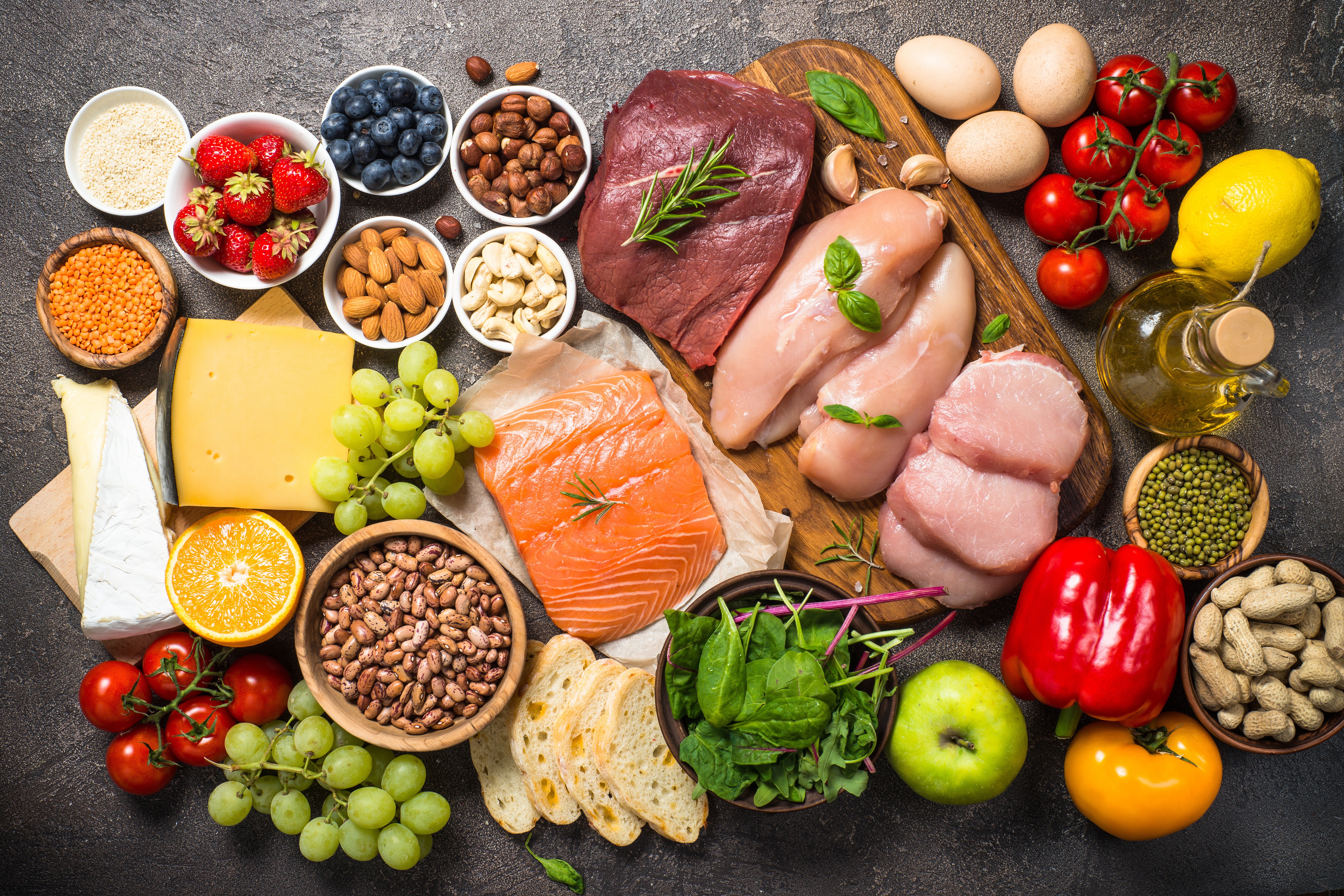As we look ahead to 2025, the food landscape is evolving in fascinating ways. With a focus on wellness, convenience, and sustainability, new trends are emerging, and old ones are waning. We spoke with nutrition experts who attended this year’s Food and Nutrition Conference and Expo (FNCE) and here are the top trends they’re buzzing about for 2025.
Gut health and functional ingredients
Gut health will remain a major focus in 2025, with products rich in prebiotics and probiotics popping up across categories. Dietitian and diabetes educator René Ficek noted that gut health is central to wellness, and brands are capitalizing on this with probiotic-enriched snacks and drinks. “Food companies are adding these ingredients to a variety of offerings, from sparkling water to supplements, shakes, and bars,” she says.
Registered dietitian Carla Hernandez adds that the market for functional sparkling water is booming. “Companies like Good Idea are taking it to another level, creating beverages that reduce blood sugar when consumed with a meal. This is a game changer for people who want to better manage their blood sugar,” she explains. These sparkling drinks combine gut-friendly benefits with adaptogens and vitamins, making them a one-stop shop for health-conscious consumers.
Fiber is still the focus
Fiber is making a strong comeback, with several brands focusing on high-fiber products that appeal to consumers’ desire for better digestion and lasting fullness. Sports dietitian Sarah Alsing is excited about this trend, emphasizing that 95 percent of Americans aren’t meeting their daily fiber needs. She shares, “I was happy to find Fiber Gourmet, a pasta brand with more than 22 grams of fiber per serving, 3 Farm Daughters pasta with 9 grams of fiber per serving, and Olyra Breakfast Biscuits, which deliver 9 grams of fiber from ancient Greek grains.”
Community and media dietitian Alyssa Smolen echoes the importance of fiber, noting that Olipop has been making waves with its low-sugar, high-fiber sodas. She says, “More companies are creating functional foods with fiber, showing that they’re listening to consumer needs for better digestive health.” This food trend isn’t going anywhere anytime soon.
Samantha DeVito, a registered dietitian and certified nutrition specialist, adds that she’s seeing a ton of products with pre and probiotic fibers. “Sparkling beverages like Wildwonder and Olipop are incorporating fibers from sources such as Jerusalem artichoke and chicory root,” she says. “This focus on prebiotic fiber is just another way companies are supporting gut health and overall wellness.”
Protein-packed foods for on-the-go
Protein remains a hot commodity, with nutrition experts noticing an uptick in convenient, high-protein options. Beth Keeton, owner of Elephant House PR, points out that brands such as Chobani and ¡Yo Quiero! are leading the charge, offering Greek yogurt cups with 20 grams of protein and Avocado & Egg cups that are easy to grab on busy mornings. “Honey Smoked Fish Co. also impressed with their smoked salmon ‘stackers,’ offering 13 grams of protein per serving,” she says, underscoring the convenience factor.
Hernandez also highlights P-nuff Crunch, which uses navy bean and rice protein to elevate the typical snack puff. “There’s a big trend in eating higher protein foods right now, and food brands are following suit, creating higher protein snacks that still taste higher carb, but with a more favorable nutritional profile,” she explains.
Another company, WILDE, caters to omnivores and uses chicken and egg whites as the primary protein in its chips. Hernandez notes, “WILDE offers all the original flavors, including my personal favorite, Sea Salt and Vinegar.”
High-protein products from grains and legumes
As more consumers seek nutrient-dense foods, grains, and legumes that naturally contain higher protein and fiber are gaining attention.
Jennifer House, MSc, RD, highlights several standout products from the conference that make the most of grains and legumes. “Cahokia rice is naturally higher in protein than regular rice, and it’s tested for heavy metals, which is important given the concerns around rice safety,” she shares. It comes in both white and brown varieties.
House also points to Zego oats, which pack more protein than traditional oats at 10 grams per serving. They’re also also free from common food allergens and food dyes, and and are tested for heavy metals and pesticide residue. Another innovative product is Struseli Granola, made with tiger nuts, nuts, and seeds, offering a satisfying crunch without added sugar.
You’ve probably seen lots of chickpea products on the market in the snack aisle in the past few years, and that category is growing. “Garbanzo bean-based treats, snacks, and wraps are taking the food world by storm,” adds Kaytee Hadley, MS, RDN, IFMCP, CPT, a functional medicine dietitian. “With their allergen-friendly nature, abundant fiber and protein, and delicious taste, products like Whoa Dough’s cookie dough bars make for a more nutrient-dense alternative to the usual refined grain options.” They’re plant-based and contain at least three grams of protein per serving.
Mushroom-based foods and adaptogenic add-ins
The fascination with fungi continues to grow, with mushroom-based products emerging as sustainable alternatives to traditional proteins. Hadley highlights Nature’s Fynd for its innovative use of fungi to create cream cheese, yogurt, and plant-based meat. She explains, “These products offer a delicious and environmentally friendly alternative to traditional meat and dairy, with textures that make them familiar and satisfying.”
House notes that adaptogenic mushrooms such as lion’s mane are being added to various products. She mentions Zego Oats, Tenzo Mushroom Matcha, and Host Defense as examples that demonstrate how mushrooms can be used to boost brain and immune health.
Meanwhile, Ficek points out that mushrooms are not only versatile but also pack a potent health punch. “Mushrooms are making a big impact as their bioactive compounds gain recognition for their anti-inflammatory, anticancer, and antiviral properties,” she notes. This year at FNCE, she observed a surge in mushroom-based supplements, broths, and foods featuring varieties like reishi and lion’s mane, all promoting benefits for immunity and overall wellness.
Focus on avocado oil
Avocado oil will continue to gain traction as a preferred cooking and ingredient oil due to its heart-healthy profile and versatility. Registered dietitian nutritionist Mackenzie Burgess observed that many brands at FNCE were embracing avocado oil for its monounsaturated fats and high smoke point, making it a staple for various products.
For instance, Primal Kitchen showcased a new line of dipping sauces made with avocado oil as the primary ingredient. Burgess also noted that Beyond Meat featured their “newly reformulated Beyond Burger and Beyond Beef, where they’ve swapped coconut and canola oils for avocado oil, reducing the saturated fat to just 2 grams per serving.”
Beyond also previewed their Sun Sausage, made with avocado oil and coming in Cajun, pesto, and pineapple jalapeño flavors. These flavor-forward links are made from wholesome plant-based ingredients and have 12 grams of protein per link, with just 1 gram of saturated fat.
“Swicy” flavors
Spicy food shows zero signs of waning in popularity, but there’s a bit of twist emerging: “swicy,” where sweet meets spicy. Keeton witnessed this firsthand at FNCE’s Trivia Night, where Natural Delights Medjool Date Strips paired with tajin captivated attendees. “The blend of rich, caramel-like dates and chili lime heat showcased the potential of this flavor combination,” she notes.

Fresh ingredients
Keeton also emphasizes the growing presence of fresh ingredients, from GoGo Squeez’s applesauce enhanced with sweet potatoes and zucchini, a lunchbox staple for the past few years, to Milton’s (and other brands) cauliflower crust pizzas. “Fresh produce took center stage on the show floor, with innovative brands weaving fruits and veggies into everyday products,” she says. People are looking for more real foods in their convenience products.
“From fresh orange juice and prunes to fresh fruits and veggies via the Foundation for Fresh Produce, there were constant reminders that while packaged foods have a place in everyone’s diets, fruits and vegetables should remain the foundation of our recommendations to clients and patients,” adds Kelly Jones MS, RD, CSSD, LDN.
Consumers want transparency, and brands are responding with more straightforward ingredient lists and fewer additives. For example, Qianzhi Jiang, PhD, RDN, LDN, Owner of The Nutrition Changer noted, “That’s It Fruit Bars have fruit as the only ingredient on the list.”
“What a great way to pack fruit for school or a longer road trip without worrying about shelf life,” says DeVito.
Performance nutrition and supplements
For athletes and active individuals, performance-focused nutrition and supplements are on the rise. Jones highlights the importance of products designed for busy, on-the-go lifestyles. “As a sports dietitian, when it comes to performance nutrition, both Huel and Timeline stood out,” she shares.
Huel offers a plant-based, ready-to-drink meal replacement shake that packs 35 grams of protein, 400 calories, and 27 vitamins and minerals into a single bottle. “This is perfect for my athletes and highly active clients who travel often and need convenient, nutrient-rich mini meals for recovery or between main meals,” explains Jones.
She also points to Timeline’s Mitopure, which contains urolithin A—a compound linked to mitochondrial health and enhanced muscular performance. “While urolithin A can be naturally produced in the gut by ingesting antioxidant ellagitannins, only about 40% of people may have the right gut microbiome to do this effectively. Timeline offers a consistent source of this compound, which is exciting for sports nutrition,” she adds.
What’s fading: keto, green powders, and vegan-specific labels
While the keto craze has dominated for years, Burgess points out that keto marketing is losing steam. She’s noticed a shift toward broader claims like “zero added sugar” or “no sweeteners,” as seen with Chobani and Struesli granola.
Hernandez adds that green powders, once ubiquitous, were notably absent at FNCE. “I was surprised to not see any new companies at FNCE and no returning companies from the bigger names in the green powder space,” she explains.
While vegan products aren’t going anywhere, dietitians like Ficek and Smolen note a shift away from overt vegan branding. Instead, brands are focusing on health-forward benefits like high fiber or low sugar to promote their products, rather than strict plant-based marketing.
As 2025 approaches, it’s clear that the food landscape is shifting toward more thoughtful, nutrient-dense, and inclusive options. From gut health to performance nutrition, these trends highlight a move toward products that align with consumer desires for convenience, transparency, and overall wellness.
What foods and trends are you looking forward to in 2025?


